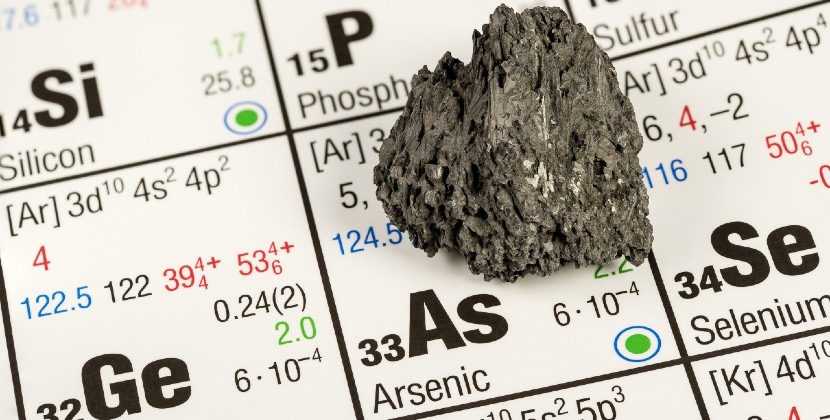
DogFoodAdvisor is reader supported See how
Dog Food Advisor is 100% impartial and is never paid to promote any brand. But if you buy using links on this page, we may earn a referral fee.
When you hear the word ‘arsenic’ you might think of some poor soul being bumped off in an Agatha Christie novel. However, this tool of melodramatic murder is commonly found — including pet food.
Don’t panic. There’s no need to call on Marple or Poirot. At least, not yet. Arsenic is a naturally occurring substance that’s not always harmful. This is why we’ve decided to tell you everything you need to know about arsenic and, specifically, arsenic in pet food.
What is arsenic?
Arsenic is a chemical element found naturally in the Earth’s crust. It is classified as a metalloid, possessing properties of both metals and nonmetals. You might find it mixed with other elements in things like rocks, soil, or water. Arsenic comes in different forms, but the ones we often talk about are inorganic and organic types.
People have used arsenic for different things over time, like in pesticides or to preserve wood. But too much exposure to arsenic can cause serious health problems in humans and animals alike.
Is all arsenic toxic?
There are over 20 forms of arsenic which fall into two categories: organic and inorganic. Often the type found in foods is the organic, and safer variety. This is abundant in the sea and tends to be found in fish — like many other elements, it bioaccumulates within the marine food chain.
Also, pork fat is found to have higher concentrations of organic arsenic than fish oil and poultry fat.
The inorganic varieties of arsenic, such as arsenite, are the more toxic varieties. This type is classified as a carcinogen (i.e. it causes cancer) and should be avoided in a diet.
Some varieties of rice can contain considerable quantities of inorganic arsenic. For more information about how rice is a source of arsenic, and which rice varieties to be most careful with check out this article: Arsenic in Rice May Also Affect Dog Food.
How much arsenic is safe?
There are a few different sources of guidance when it comes to maximum levels of arsenic in animal foods:
- The legal limit of arsenic set by Directive 2002/32/ EC is 2mg per kilogram of bodyweight in complete feed and 4mg kg in complementary feed.
- Regulation 2012/744/EC2 set a maximum level of 10mg/kg for arsenic in compound feed.
- Toxicological studies concerning pet food have shown that adverse effects were associated with long-term ingestion of inorganic arsenic at doses of at least 2.4 mg/kg body weight per day (EFSA 2009).
- The maximum tolerated level of arsenic for cats and dogs according to the United States Food and Drug Administration (2011) is 12.5mg/kg.
Even though the legal safety limit of total arsenic content may not be exceeded in many pet foods, inorganic arsenic is considered a “non-threshold carcinogen”, which means any exposure is a health risk.
Recently there have been recommendations to limit rice intake in people, particularly for rice cereals in babies, which you can read more about here.
Arsenic in pet food
In a study examining the heavy metal contamination in pet foods, arsenic values over the maximum tolerated levels (10mg per kg of bodyweight) were not found. The conclusion was that there are no intoxication risks through long-term consumption of pet food.
The variety of arsenic, whether organic or inorganic, was not specified, and the recipes or ingredients of the foods were not given, so it is not known whether the foods chosen for analysis included rice, or whether the arsenic present is from other sources such as fish.
A second study measured inorganic arsenic in hair (urine is also a known indicator of inorganic arsenic exposure). Organic arsenic does not accumulate in hair. They concluded that dogs eating a rice-based dry food diet had higher inorganic arsenic levels in their hair than dogs that didn’t eat rice.
It’s been suggested eating rice-based diets long-term risks chronic inorganic arsenic exposure. One way you can help your dog avoid overexposure to possible arsenic-containing ingredients is to use diet rotation, which is the practice of feeding a variety of different recipes with different ingredients.
So where does this leave us?
AAFCO recommends that, for quality standards to be maintained, testing of each production batch of food should include checks for potential hazardous substances. This includes testing for heavy metals, one of which is arsenic.
There are still questions unanswered here, however. The maximum tolerated level of arsenic is not for inorganic arsenic, but arsenic as a total. As inorganic arsenic is where the risks to health lie, this is the value which we believe is of greatest importance.
The maximum tolerated level of arsenic at 10 mg/kg gives space for inorganic arsenic to be present well above the dietary level of 2.4mg per kilogram of body weight linked with adverse health effects.
We don’t provide this information to worry anybody; it’s a source of information to follow on from previous posts regarding arsenic in dog food. We aren’t suggesting that rice is a bad ingredient and should be avoided from now on, but simply making you aware that, like with many elements of food and nutrition, there are risks of contamination and from continuous exposure.
Afterall, many pets thrive on diets including rice, and rice forms a staple part of the diet for many people across the globe.
Our advice remains that dietary rotation is beneficial to avoid continuous exposure. Reaching out to your pet food brand to ask for the quantity of inorganic arsenic present could also be worthwhile.
Final word
The Dog Food Advisor does not accept money, gifts, samples or other incentives in exchange for special consideration in preparing our reviews.
However, we do receive a referral fee from online retailers (like Chewy or Amazon) and from sellers of perishable pet food when readers click over to their websites from ours. This helps cover the cost of operation of our free blog. Thanks for your support.
For more information, please visit our Disclaimer and Disclosure page.
Article reviewed by
Andrew Dickens
Editor
Andrew Dickens is an award-winning writer, editor and broadcaster with 20 years in journalism. He’s created compelling content on film and television, travel, food and drink, physical and mental health, business, sport, technology and politics. And, of course, dog food.




